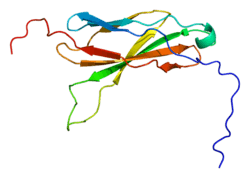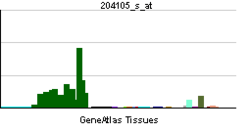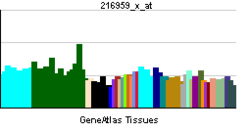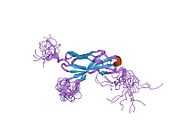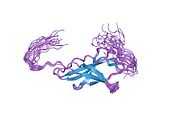NRCAM
Neuronal cell adhesion molecule is a protein that in humans is encoded by the NRCAM gene.[1][2]
Cell adhesion molecules (CAMs) are members of the immunoglobulin superfamily. This gene encodes a neuronal cell adhesion molecule with multiple immunoglobulin-like C2-type domains and fibronectin type-III domains. This ankyrin-binding protein is involved in neuron-neuron adhesion and promotes directional signaling during axonal cone growth. This gene is also expressed in non-neural tissues and may play a general role in cell-cell communication via signaling from its intracellular domain to the actin cytoskeleton during directional cell migration. Allelic variants of this gene have been associated with autism[3] and addiction vulnerability. Alternative splicing results in multiple transcript variants encoding different isoforms.[2]
References
- ↑ Lane RP, Chen XN, Yamakawa K, Vielmetter J, Korenberg JR, Dreyer WJ (Dec 1996). "Characterization of a highly conserved human homolog to the chicken neural cell surface protein Bravo/Nr-CAM that maps to chromosome band 7q31". Genomics 35 (3): 456–65. doi:10.1006/geno.1996.0385. PMID 8812479.
- ↑ 2.0 2.1 "Entrez Gene: NRCAM neuronal cell adhesion molecule".
- ↑ Marui T, Funatogawa I, Koishi S et al. (2008). "Association of the neuronal cell adhesion molecule (NRCAM) gene variants with autism". Int J Neuropsychopharmacol 12 (1): 1–10. doi:10.1017/S1461145708009127. PMID 18664314.
Further reading
- Grumet M (1997). "Nr-CAM: a cell adhesion molecule with ligand and receptor functions". Cell Tissue Res. 290 (2): 423–8. doi:10.1007/s004410050949. PMID 9321706.
- Sakurai T, Lustig M, Nativ M et al. (1997). "Induction of neurite outgrowth through contactin and Nr-CAM by extracellular regions of glial receptor tyrosine phosphatase beta". J. Cell Biol. 136 (4): 907–18. doi:10.1083/jcb.136.4.907. PMC 2132488. PMID 9049255.
- Nagase T, Ishikawa K, Nakajima D et al. (1997). "Prediction of the coding sequences of unidentified human genes. VII. The complete sequences of 100 new cDNA clones from brain which can code for large proteins in vitro". DNA Res. 4 (2): 141–50. doi:10.1093/dnares/4.2.141. PMID 9205841.
- Wang B, Williams H, Du JS et al. (1998). "Alternative splicing of human NrCAM in neural and nonneural tissues". Mol. Cell. Neurosci. 10 (5–6): 287–95. doi:10.1006/mcne.1997.0658. PMID 9604207.
- Moré MI, Kirsch FP, Rathjen FG (2001). "Targeted ablation of NrCAM or ankyrin-B results in disorganized lens fibers leading to cataract formation". J. Cell Biol. 154 (1): 187–96. doi:10.1083/jcb.200104038. PMC 2196853. PMID 11449000.
- Dry K, Kenwrick S, Rosenthal A, Platzer M (2001). "The complete sequence of the human locus for NgCAM-related cell adhesion molecule reveals a novel alternative exon in chick and man and conserved genomic organization for the L1 subfamily". Gene 273 (1): 115–22. doi:10.1016/S0378-1119(01)00493-0. PMID 11483367.
- Jenkins SM, Bennett V (2002). "Ankyrin-G coordinates assembly of the spectrin-based membrane skeleton, voltage-gated sodium channels, and L1 CAMs at Purkinje neuron initial segments". J. Cell Biol. 155 (5): 739–46. doi:10.1083/jcb.200109026. PMC 2150881. PMID 11724816.
- Aitkenhead M, Wang SJ, Nakatsu MN et al. (2002). "Identification of endothelial cell genes expressed in an in vitro model of angiogenesis: induction of ESM-1, (beta)ig-h3, and NrCAM". Microvasc. Res. 63 (2): 159–71. doi:10.1006/mvre.2001.2380. PMID 11866539.
- Pavlou O, Theodorakis K, Falk J et al. (2002). "Analysis of interactions of the adhesion molecule TAG-1 and its domains with other immunoglobulin superfamily members". Mol. Cell. Neurosci. 20 (3): 367–81. doi:10.1006/mcne.2002.1105. PMID 12139915.
- Conacci-Sorrell ME, Ben-Yedidia T, Shtutman M et al. (2002). "Nr-CAM is a target gene of the beta-catenin/LEF-1 pathway in melanoma and colon cancer and its expression enhances motility and confers tumorigenesis". Genes Dev. 16 (16): 2058–72. doi:10.1101/gad.227502. PMC 186445. PMID 12183361.
- Nakayama M, Kikuno R, Ohara O (2003). "Protein-protein interactions between large proteins: two-hybrid screening using a functionally classified library composed of long cDNAs". Genome Res. 12 (11): 1773–84. doi:10.1101/gr.406902. PMC 187542. PMID 12421765.
- Strausberg RL, Feingold EA, Grouse LH et al. (2003). "Generation and initial analysis of more than 15,000 full-length human and mouse cDNA sequences". Proc. Natl. Acad. Sci. U.S.A. 99 (26): 16899–903. doi:10.1073/pnas.242603899. PMC 139241. PMID 12477932.
- Hillier LW, Fulton RS, Fulton LA et al. (2003). "The DNA sequence of human chromosome 7". Nature 424 (6945): 157–64. doi:10.1038/nature01782. PMID 12853948.
- Custer AW, Kazarinova-Noyes K, Sakurai T et al. (2003). "The role of the ankyrin-binding protein NrCAM in node of Ranvier formation". J. Neurosci. 23 (31): 10032–9. PMID 14602817.
- Ota T, Suzuki Y, Nishikawa T et al. (2004). "Complete sequencing and characterization of 21,243 full-length human cDNAs". Nat. Genet. 36 (1): 40–5. doi:10.1038/ng1285. PMID 14702039.
- Hutcheson HB, Olson LM, Bradford Y et al. (2004). "Examination of NRCAM, LRRN3, KIAA0716, and LAMB1 as autism candidate genes". BMC Med. Genet. 5: 12. doi:10.1186/1471-2350-5-12. PMC 420465. PMID 15128462.
- Bonora E, Lamb JA, Barnby G et al. (2005). "Mutation screening and association analysis of six candidate genes for autism on chromosome 7q". Eur. J. Hum. Genet. 13 (2): 198–207. doi:10.1038/sj.ejhg.5201315. PMID 15523497.
- Ishiguro H, Liu QR, Gong JP et al. (2006). "NrCAM in addiction vulnerability: positional cloning, drug-regulation, haplotype-specific expression, and altered drug reward in knockout mice". Neuropsychopharmacology 31 (3): 572–84. doi:10.1038/sj.npp.1300855. PMID 16123759.
| |||||||||||
